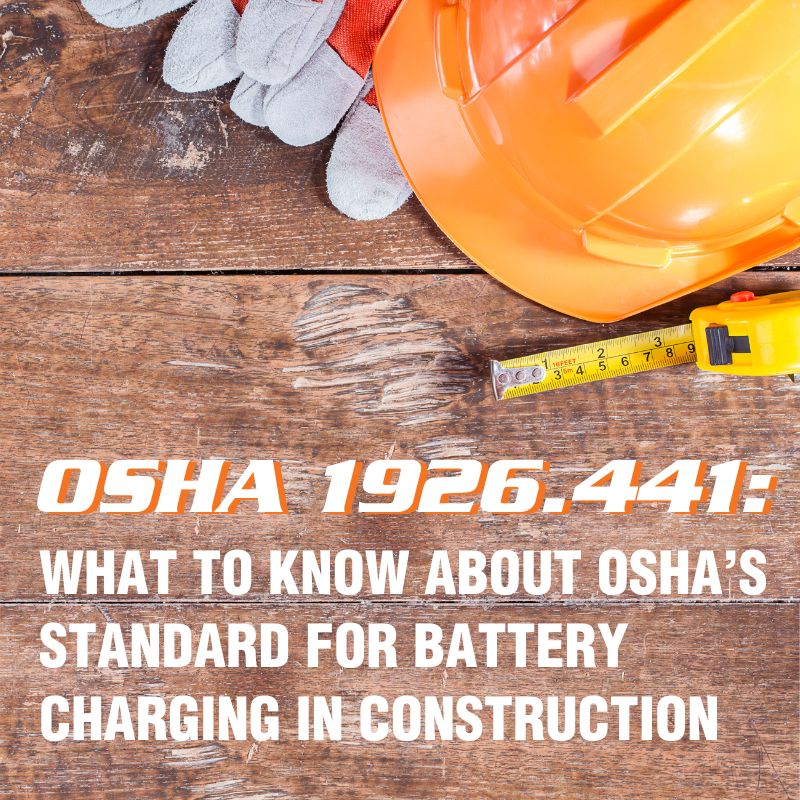We use cookies to make your experience better. To comply with the new e-Privacy directive, we need to ask for your consent to set the cookies. Learn more.
OSHA 1926.441: What to Know About OSHA’s Standard for Battery Charging in Construction
The Occupational Safety and Health Administration (OSHA) standards address battery charging areas in the construction industry in OSHA 1926.441, a rule on “batteries and battery charging.” For the same topic in general industry (as opposed to construction alone), the relavent standard is OSHA 1910.178(g), which we’ve covered extensively — here, for instance. 
Compared to the battery room standards for general industry, OSHA rules for the construction field are relatively simple. The two standards overlap in most meaningful ways, but standard 1926.441 omits the requirement to provide specialized battery handling equipment in battery charging areas. That’s odd, because the electric industrial trucks used in construction certainly don’t require smaller, lighter batteries than the forklifts covered by the 1910 standards.
At any event, the specific rules found in OSHA 1926.441 essentially cover three aspects of the battery charging area at a construction site:
- Composition of the battery room and its infrastructure: According to OSHA 1926.441, battery rooms — or “battery charging installations,” as the OSHA language has it — must be “located in areas designated for that purpose” (1926.441[b][1]). Placement should never be improvised or haphazard. Additionally:
- Chargers must be “protected from damage by trucks” (1926.441[b][2]).
- Battery racks and Drip Pans must be “substantial” and “resistant to the electrolyte,” which is to say, acid-resistant (1926.441[a][3]).
- Floors must also resist acidic drips and spills, or else be otherwise “protected from acid accumulations” (1926.441[a][4]).
- Personal protective equipment and safety stations: OSHA 1926.441 requires employers to provide necessary personal protective equipment to workers who handle electrolyte and/or batteries. Safety equipment must also be present in the battery charging area.
- Required PPE includes acid-resistant “face shields, aprons, and rubber gloves” (1926.441[a][5]).
- Eye wash stations and/or emergency showers must be present within 25 feet of any area where workers handle batteries (1926.441[a][6]).
- Employers must also provide Battery Spill Kits or some other means of “flushing and neutralizing spilled electrolyte” (1926.441[a][7]).
- Fire protection devices such as fire extinguishers must also be available to workers in battery charging areas (1926.441[a][7]).
- Treatment of sealed versus flooded traction batteries: Unlike its counterpart in general industry, OSHA 1926.441 recognizes the difference between flooded and sealed industrial batteries. Two sections of the construction standard address flooded batteries in particular:
- Flooded batteries “shall be located in enclosures with outside vents or in well-ventilated rooms and shall be arranged so as to prevent the escape of fumes, gases, or electrolyte spray into other areas” (1926.441[a][1]).
- Vent caps must remain in place during the charging cycle of unsealed batteries, and those vent caps must be well-maintained (1926.441[b][3]).
- While this latter standard doesn’t mention sealed batteries per se, it seems to apply only to the flooded type; sealed batteries vent gasses through nonremovable valves rather than vent caps.
It is unclear why the battery-handling standard for construction doesn’t require employers to provide “a conveyor, overhead hoist, or equivalent material handling equipment” for changing batteries, like the 1910 standard for general industry. After all, without adequate battery handling equipment, it’s impossible to change batteries in industrial trucks.
The omission of forklift battery handling equipment in the 1926 standards suggests that they were written with stationary power batteries in mind. However, OSHA 1926.441 is still the relevant standard covering motive power batteries, which show up on construction sites with increasing regularity.
Maybe the assumption is that truck operators at construction sites can lift batteries with forklifts themselves. This is possible to do safely and efficiently with an appropriate Fork Attachment and Battery Lifting Beam. However, this only functions for lift trucks that provide access to batteries through vertical extraction.
Industrial trucks outfitted for side-extraction will still require, at the very least, Battery Carts or Carriages such as an Automatic Transfer Carriage. Whether it’s mentioned in OSHA 1926.441 or not, battery handling equipment is an important part of safe, efficient battery use in the construction industry and beyond.
References:
“29 CFR 1910.178 - Powered industrial trucks.” OSHA. U.S. Occupational Safety and Health Administration, n.d. Web. 11 Dec. 2019.
“29 CFR 1926.441 - Batteries and battery charging.” OSHA. U.S. Occupational Safety and Health Administration, n.d. Web. 7 Dec. 2019.
“Sealed Battery.” ScienceDirect. Elsevier B.V., 2011. Web. 11 Dec. 2019.
